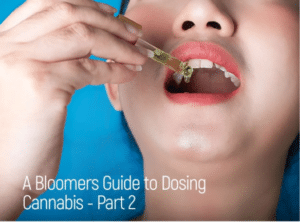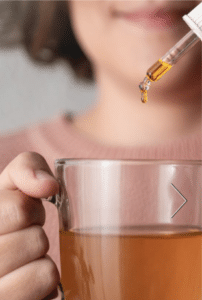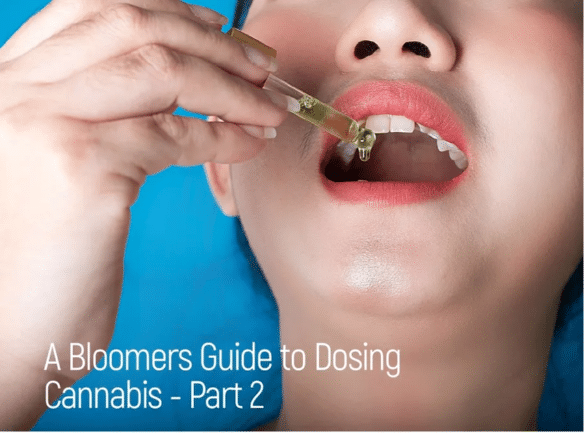Part 2 of the cannabis dosing guide talks about dosing for edible oils, CBD, and other cannabinoids.

by Jeremy Jacob
Part 1 of our Dosing Guide was published in the March/April issue of Cannabis Retailer. We talked about edibles and inhaling, the two most popular ways to consume cannabis. In Part 2, we’ll talk about dosing for edible oils, CBD, and other cannabinoids.
Edible Oils
Edible oils are popular among consumers who want a quick onset but don’t want to smoke or vape, or for consumers looking to dial in on the right dose for them. Oils let consumers vary their dose with greater accuracy and flexibility than other edible formats.
Oils are flexible not just in the amount you can take, but in the pathway the body uses to absorb them.
Edible Pathway
Oils can be swallowed and then they follow the same pathway as capsules or other edibles. From Part 1, we know it can take up to two hours to feel the effects of edibles, which can last up to 24 hours. This is due to the metabolic process in the liver where Delta-9-THC, the compound found in inhaled products, is converted to 11-Hydroxy-THC, which is more potent and longer lasting.
Sublingual Pathway
When edible oils are absorbed through the mucus membranes in the mouth, they have a quick onset, second to inhaling. They enter directly into your bloodstream, bypassing the digestive tract and the liver.
There are two main mucus membranes in the mouth: sublingual membranes which are under the tongue, and the buccal membranes that are in the cheeks. To maximize absorption, place the oil under your tongue, press your tongue to the roof of your mouth for 60-90 seconds to flush your mucus membranes, then swallow. From here, remaining cannabinoids are absorbed in the digestive tract, much like an edible. “Oil pulling” with cannabinoids for up to 20 minutes has been increasing in popularity and ensures most cannabinoids are absorbed in the mouth.
Some folks say they begin to feel tinctures almost immediately, but typically you can expect to feel your sublingual dose within 5-30 minutes, and the full effect within about 90 minutes to two hours. Effects can last from four to 12 hours depending on your dose and your metabolism.
 Oils can be added to hot drinks, smoothies, salad dressings, baked recipes, popcorn, yogurt, guacamole, almost anything. Depending on the way you consume them, the oil can give you a sublingual dominant effect, an edible effect, or a combination of both.
Oils can be added to hot drinks, smoothies, salad dressings, baked recipes, popcorn, yogurt, guacamole, almost anything. Depending on the way you consume them, the oil can give you a sublingual dominant effect, an edible effect, or a combination of both.
Sublingual Dosing
THC
As a new edible oil consumer, “Start low and go slow” applies. For THC oils, a good starting place is the same 2 -2.5mg starting dose that is recommended for edibles. If you don’t feel this dose, wait at least two hours before taking more, and repeat the same dose three times before increasing the dose. When doing that, small increments are recommended as opposed to doubling your amount.
CBD is not psychoactive, and larger doses don’t have the same risk of an overwhelming experience that THC can deliver. With CBD oils, 10-15mg is a safe starting dose for most people. If you’re looking for a particular effect from CBD, such as stress relief, and you don’t feel a benefit from the dose you’ve taken, it’s safe to repeat the dose within 30-60 minutes.
CBD can have a drowsy effect on some consumers, so always do your experimenting when you’re in a safe place.
CBG
Cannabigerol (CBG) is a minor cannabinoid that is increasingly being featured in oils and edibles. CBG is the precursor form of THC, CBD, and other cannabinoids. CBG is non-intoxicating and is similar to CBD in many ways. While not as well researched as THC and CBD, studies have shown it to have potential for inflammation, depression, and anxiety. CBG may increase dopamine levels and support sleep and appetite regulation.
Dosing CBG is much like CBD—a starting dose of 10-15mg is fine. Self-analyze for your desired benefits, and take another dose within an hour or so if you feel the need to.
CBN
Cannabinol (CBN) is another minor cannabinoid and the breakdown product of THC (i.e., as THC ages it converts to CBN). CBN is mildly psychoactive and about ¼ the potency of THC. Recently, CBN has been gaining in popularity as a potential aid for relaxation and sleep. For this effect, CBN has been found to be effective in doses from 5-15mg. The right dose is the smallest that gives the desired effect, so 5mg is a safe starting point. If it’s combined with other cannabinoids, base your dose on the THC content and use 2-2.5mg as your starting dose. Follow the guidelines set up earlier for repeating and increasing your dose.
